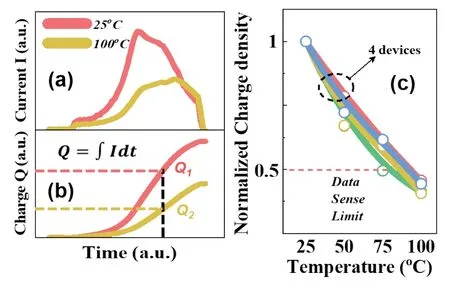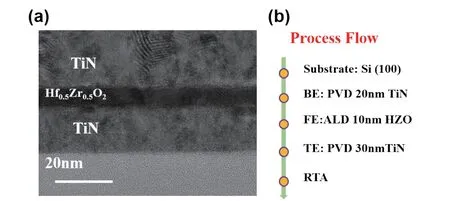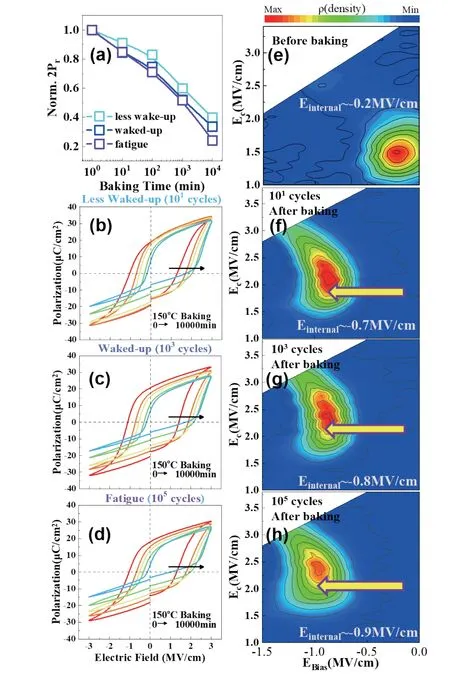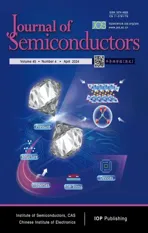On the relationship between imprint and reliability in Hf0.5Zr0.5O2 based ferroelectric random access memory
2024-04-23PengYuanYutingChenLiguoChaiZhengyingJiaoQingjieLuanYongqingShenYingZhangJibinLengXueliMaJinjuanXiangGuileiWangandChaoZhao
Peng Yuan, Yuting Chen, Liguo Chai, Zhengying Jiao, Qingjie Luan, Yongqing Shen, Ying Zhang,Jibin Leng, Xueli Ma, Jinjuan Xiang, Guilei Wang, and Chao Zhao
Beijing Superstring Academy of Memory Technology, Beijing 100176, China
Abstract: The detrimental effect of imprint, which can cause misreading problem, has hindered the application of ferroelectric HfO2.In this work, we present results of a comprehensive reliability evaluation of Hf0.5Zr0.5O2-based ferroelectric random access memory.The influence of imprint on the retention and endurance is demonstrated.Furthermore, a solution in circuity is proposed to effectively solve the misreading problem caused by imprint.
Key words: FeRAM; HZO; imprint; reliability
doi: 10.1088/1674-4926/45/4/042301
1.Introduction
Ferroelectric memory (FRAM) offers unique capabilities which make it an attractive non-volatile memory choice for many applications[1-3].Since Bo¨sckeet al.discovered the ferroelectricity in nanoscale HfO2in 2011 for the first time[4], the scaling down problem that plagues traditional ferroelectricity has been greatly promoted.Meanwhile, ferroelectric HfO2(FE-HfO2) starts a new future for memory generations due to its distinctive features include RAM-like, write speeds, low voltage, low power write operation, high cycling endurance lifetime and architectural flexibility[5-7].However, certain reliability issues must be satisfactorily resolved before they can be widely applied in commercial memories.Imprint problem, as one of the reliability issues of FE-HfO2, becomes a critical concern for ferroelectric applications such as ferroelectric memory (FeRAM), ferroelectric field-effect transistors (Fe-FETs),and ferroelectric diode[8-10].Take FeRAM as an example, the presence of imprint effect will cause the misreading problem in FeRAM 1T-1C array, as illustrated in Fig.1, retarding its further development.As the coercive field (Ec) of hafnium-based ferroelectricity is usually quite large (1-2 MV/cm) compared with traditional ferroelectric materials (Ecabout 1-10 kV/cm),Ecshift caused by imprint in FE-HfO2is more serious problem and poses a huge challenge: On the one hand, although the relative rate ofEcchange is not significant, the absolute amount ofEcchange may also be significant.On the other hand, the shiftedEcis close to breakdown electric field,which leads to very limited tolerance and bad endurance.Figs.2(a) and 2(b) show the sense current for bit “1” during read operation at 25 and 100 ℃ and the corresponding sensing chargeQ, whereQis the integration of current peaks.At the same integration time,Qvalue decreases at high temperature.As a result, the sense margin, which is defined as the separation between the highest bit "0" and lowest bit "1", can then decrease and may cause read fails at high temperature as shown in Fig.2(c).The misreading problem caused by imprint seriously affects the practical applications of FeRAM.Therefore, it is necessary to analyze and solve it with in-depth understanding of the mechanism.There have been some reports on the imprint mechanism of hafnium-based ferroelectric[10,11].However, how the imprint of hafnium-based ferroelectricity affects the reliability of the FRAM technology, is still missing.

Fig.1.(Color online) (a) The schematic diagram of the typical FeRAM 1T-1C array, in which the transistors are controlled by WLs and the ferroelectric capacitors are controlled by PLs and BLs.(b) The readout circuit of the FeRAM 1T-1C bit-cell.(c) Timing diagrams for the read operation scheme of the 1T1C FeRAM cell for data "0" and data "1".Misreading occurs at high temperature (100 ℃).

Fig.2.(Color online) (a) and (b) The sensing current and corresponding charge for bits "1" during read operations at 25 and 100 ℃.(c) For FE devices, pronounced reduction in switching polarization signal reading at elevated temperature is observed.The sense margin may decrease when operating at high temperature (100 ℃).
In this work, we systematically investigated the influence of imprint effect on the reliability of Hf0.5Zr0.5O2(HZO) ferroelectric capacitors, and found that imprint not only plays an important role in retention characteristic of the HZO device, but also appears in at different times in the ferroelectric cycle.In addition, it can be easily observed from statistical data that the imprint effect can lead to seriousEcshift and remanent polarization (Pr) degradation of ferroelectric units, greatly reducing the reliability of ferroelectric memories.Moreover, by using the invented solution, the misreading problem caused by imprint in circuity could be solved.
2.Materials and methods
FE-HfO2capacitor were grown on Si (100) wafer.Fig.3(a)shows the TEM image of the TiN/HZO/TiN capacitor.The fabrication process of FE devices is as follow (Fig.3(b)): Firstly, a 20-nm thick TiN bottom electrode (BE) were deposited via physical vapor deposition (PVD) method.Subsequently,10 nm HZO film were deposited by atomic layer deposition(ALD) at 280 ℃ with a Hf : Zr ratio of 1 : 1 as followed.TEMAH, TEMAZ, and H2O were served as Hf-precursor, Zr-precursor, and oxygen source, respectively.Latterly, 30-nm thick patterned TiN were deposited via PVD method as top electrode (TE).40μm × 40μm dimension square TEs were utilized for electrical tests.At the end, both HZO capacitors were annealed at 500 ℃ for 60 s in N2atmosphere using a rapid thermal annealing system (RTA).

Fig.3.(Color online) (a) The TEM image of the TiN/HZO/TiN capacitor.(b) The fabrication process of FE devices.
3.Results and discussion
3.1.Relationship between imprint and retention
When evaluating FRAM retention reliability, imprint is the most important retention reliability mechanism for FRAM[11,12].Ferroelectric memories experience more imprint when exposed to higher temperatures and longer periods of time.However, the limit of imprint in FE-HfO2has not evaluated yet.To this end, we selected a 10 nm HZO capacitor which was subjected to baking at 200 ℃ for prolonged test.As shown in Fig.4, for 10 nm HZO device,Ecgradually shifts towards the positive direction as the baking time was prolonged, and exponential growth of ΔEcwas observed within 3000 min due to the high baking temperature.However, limit imprint was discovered when the baking time was as long as 104min.The observed phenomenon can be understood by the imprint explanation in our previous work[11].It is shown that oxygen vacancies near the interface between the dielectric and electrode are at the heart of imprint in HZO.Since oxygen vacancies were unavoidably generated during the growth processes e.g., element diffusion during thermal annealing, physical bombardment during sputtering top electrode, thus, imprint is inevitably appearing.Nevertheless, the amount of oxygen vacancies in HZO film is limited and will not increase during baking, even though the baking time was increasing to 104min.It should be noted that althoughEcshift by imprint has a limit, it was obtained by baking at a high temperature of 200 ℃ for over 10 000 min, indicating that imprint has always existed in ferroelectric memories and is an inevitable phenomenon.

Fig.4.(Color online) High temperature imprint test at 200 ℃ for TiN/HZO/TiN capacitors.(a) The corresponding P-V loops for HZO devices after different baking time from 0-10 000 min.(b) Evolution of extracted ΔEc vs baking time.
To further investigate the impact of imprint on the read and write operations for FeRAM, electrical test was conducted.Fig.5 represents typical read and write operation of 1T1C FeRAM storage units.Considering the capacitor polarization state will not change when logic "0" is read, only the impact of imprint on logic "1" is considered here.Usually, the D-value in polarization between "0" and "1" of FeRAM is defined as the memory window.Hence, considering the reliability issue caused by imprint, we further investigated the degradation of the FeRAM memory in high temperature.In order to investigate the influence of the imprint on ferroelectric devices with different operating voltages, we simulated the reading and writing of FeRAM using ferroelectric capacitors and conducted retention tests.As shown in Fig.5 (b),each sample was subjected to 1000 cycles to wake up, before sent to the baking test.After that, multiple amplitude pulses(VreadandV’read) were conducted to HZO devices before and after baking in order to obtain the switching polarization(PswandP’sw) logic "1" state.As the baking time increases,which is shown in Figs.5(c) and 5(d), the subsequent read "1"operation shows a decrease in remanent polarization, and a significant degradation of the memory window is observed.Therefore, for memory application with low voltage operations or multilevel storage, imprint is a significant threat.Only by increasing the read voltage can the impact of imprint be reduced.

Fig.5.(Color online) (a) Schematic diagram of hysteresis loop of a FE capacitor caused by imprint.(b) Baking testing scheme for ferroelectric devices with different operating voltages.(c) and (d) Comparison of switching polarization of ferroelectric capacitors before and after baking.The pronounced degradation of the FeRAM memory is observed for low operation voltage devices in high temperature.
3.2.Relationship between imprint and retention
Besides imprint effect, wake-up effect and fatigue, which occur in different cycles period, are also critical reliability issues in ferroelectric capacitors[13-16].Usually, as shown in Fig.6(a), with the number of cycles increases, HZO FE capacitors exhibit three states: 1) Waking-up state—the polarization of HZO devices increases with cycling operation due to the redistribution of oxygen vacancies or the transformation of tetragonal phases into orthogonal phases[13,14]; 2) Wakedup state—The polarization of FE devices remains relatively stable as the number of cycles increases; 3) Fatigue state—Stress gradually accumulates, generating oxygen vacancies at grain boundaries, leading to a decrease in polarization and an increase in leakage[15,16].Typically, imprint measurements were conducted by using waked-up FE devices[17,18].However, the measurement of imprint for HZO capacitors during the waking-up and fatigue states has not been evaluated yet.To the end, three devices with different pre-cycles (101,103, and 105cycles) are tested as shown in Fig.6(b).After pre-set, both samples were baked at 150 ℃ in air atmosphere for a period of time to accelerate the imprint andEcshift.First order reversal curves (FORCs) were carried out for the devices before and after 103min baking at 150 ℃.FORCs test is used to measure the coercive field and internal electric field (Einternal) inside ferroelectric capacitors, which is suitable to detect the change ofEinternalcaused by imprint[19,20].Fig.7 shows the correlation between the imprint and number of cycles before baking.As Figs.7(b)-7(d) show theP-Vhysteresis loops of the MFM capacitor with 10 nm HZO film before and after high-temperature annealing.It can be observed for all samples thatEcgradually shifts towards the positive direction and thePrdecreases drastically as the baking time was prolonged.ThisEcshift andPrdecrease is more pronounced in the cases of fatigue state devices according to the statistics in Fig.7(a).The corresponding FORCs measurements after 1000 min, 150 ℃ annealing for three cases are illustrated in Figs.7(e)-7(h).As shown in Fig.7(e), the switching densities for unbaked devices is concentrated around-0.2 MV/cm (EBias), which is related to different deposition condition for TE and BE.After high temperature annealing, internal electric field shifted to negative direction for both samples, andEBiasis located near -0.7, -0.8 and -0.9 MV/cm for less waked-up samples, and well waked-up samples and fatigued samples, respectively (Figs.7(f)-7(h)).This observed phenomenon is supporting the wake-up and fatigue explanation[12-14], since cycling operation inevitably causes changes in the number or state of oxygen vacancies which is the role of imprint in HZO ferroelectric thin films.

Fig.6.(Color online) Evolution of remanent polarization with electric field cycling using rectangular pulses.The HZO FE capacitors exhibit three states: Less waked-up, waked-up and fatigue.(b) Imprint test flow for three samples.

Fig.7.(Color online) (a) ΔEc as a function of baking time with different number of cycles before bake when the FE device is fatigued, the degree of imprint was worse.(b)-(d) P-V hysteresis loops of the MFM capacitor with 10 nm HZO film before and after high-temperature annealing.(e)-(h) The corresponding FORCs measurements after 1000 min at 150 ℃ annealing for three cases.
3.3.Solution of the reliability degradation induced by imprint
To get rid of theEcshift and polarization degradation caused by imprint effect, a sensing circuit is designed to overcome the misreading problem as shown in Fig.8(a).This circuit can detect the ambient temperature of the FE capacitor,and adjust theVwriteaccording to the temperature.The array is divided into multiple banks and a temperature sensor circuit is added in each bank to better sense the temperature change, as shown in Fig.8(b).The temperature sensing circuit is designed based on the temperature characteristics of CMOS parasitic diode, which can generate a voltage proportional to temperature.After power-on, the temperature sensor in each bank is activated to generate the temperature signal such as B1, which is then input into a MUX.Memory control selects the temperature signal voltage of the bank according to the address of the target cell being operated, and was compared with the reference voltage.If the temperature is greater than 75 ℃, the working voltage is 3.5 V, otherwise it is 2 V as demonstrated in Fig.8(c).This solution is simple, fast and low-cost, and can effectively solve the misreading problem caused by the imprint of FE capacitors.

Fig.8.(Color online) The proposed sensing circuit to overcome the misreading problem.(a) and (b) Schematics of the solution and the circuit.(c)The working temperature of the selected Bank 1 changes from 25 to 85 ℃ and the write voltage then changes from 2 to 3.5 V.
4.Conclusions
In this work, the relationship between imprint and reliability of HZO-based FeRAM is systematically studied.Based on the electrical tests on extreme high temperature, imprint exists a limit in HZO capacitors but difficult to achieve.Imprint have a significant influence on the retention characteristics of the ferroelectric memory by reducing the memory window.Furthermore, imprint effect is observed during all cycling period, and is more serious in fatigue state.Based on the results, we have proposed a practical solution which could suppress the reliability degradation induced by imprint significantly.
Acknowledgments
This research was supported by the National Key R&D Program of China (Grant No.2022YFB3606900), and in part by the National Natural Science of China (Grant No.62004217).
杂志排行
Journal of Semiconductors的其它文章
- Chemical vapor deposition for perovskite solar cells and modules
- Highlights in recent wireless power IC research
- Recent advancements in continuously scalable conversion-ratio switched-capacitor converter
- Towards efficient generative AI and beyond-AI computing:New trends on ISSCC 2024 machine learning accelerators
- Millimeter-wave PA design techniques in ISSCC 2024
- Light-emitting devices based on atomically thin MoSe2
